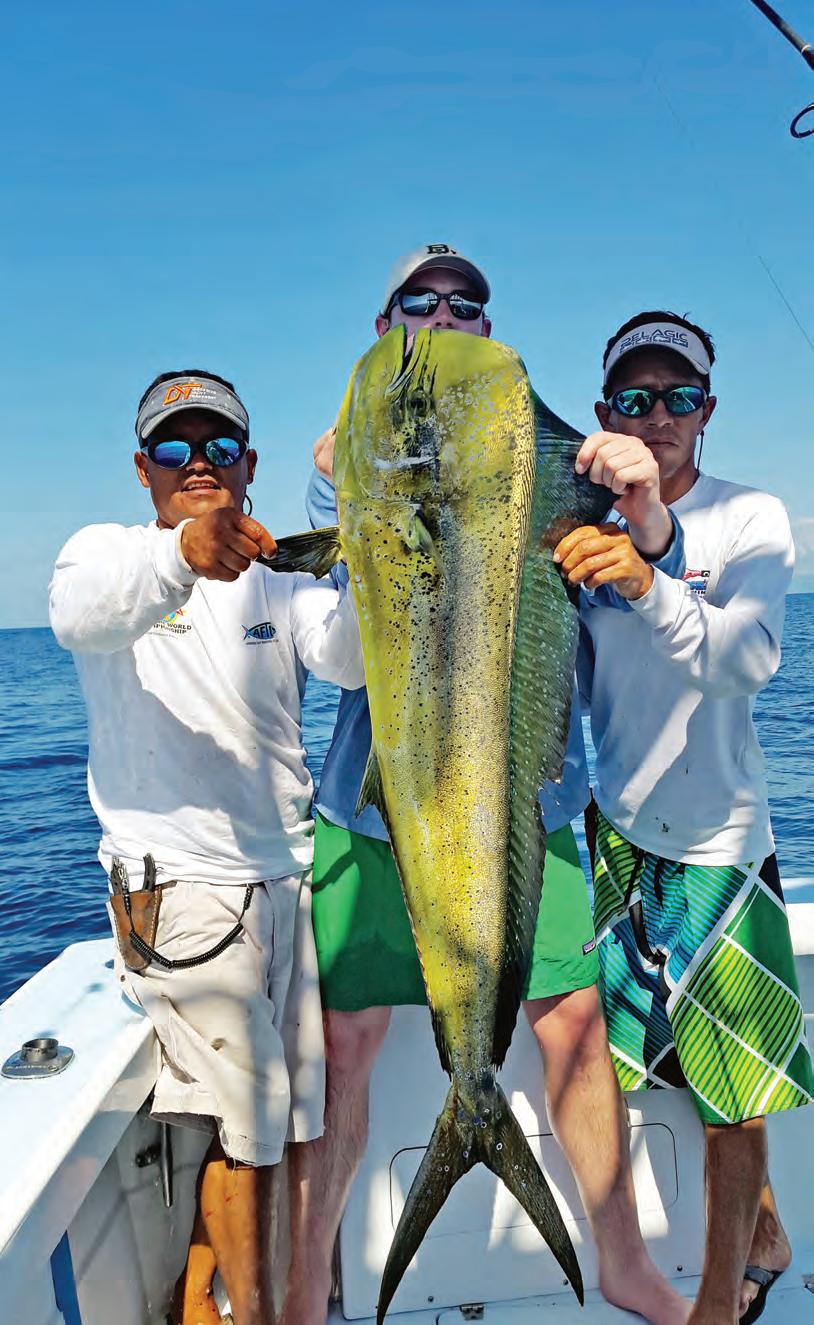
3 minute read
MAHI A Few Facts About Everyone’s Favorite Fish
By CAM Sta
On the end of a line or wrapped up in a tortilla, dolphin sh are a worldwide fan favorite. Here are a few facts you might not have known about mahi-mahi:
• What’s in a Name? Mahi-mahi is the Hawaiian term for the sh historically called dolphin or dolphin sh in the mainland United States. In Polynesian “mahi” means “strong,” and “mahi-mahi” translates to very strong. Although most U.S. scientist still refer to the species as dolphin sh, the term mahi has become more prevalent in recent years, perhaps through foodsh marketing or to avoid confusion with the mammal also called dolphin.
Spanish speakers typically refer to the same sh as “dorado,” which means “golden.” Obviously, this comes from the sh’s color, and dorado is also used widely in the Paci c as well as in English-speaking South Africa.
Dolphin sh are found in all the world’s tropical and subtropical oceans. ey go by many names in many languages. ey are Shiira in Japanese, goldmakrele in German, lambuka in Arabic… and the list goes on.
• All the Pretty Colors: Dolphin sh are revered for their gorgeous colors, which change according to their excitement level. ey can change colors and even icker from day-glow green and yellow with blue highlights to lighter blue and metallic silver over the course of a ght. As soon as you pull them out of the water, this brilliance begins to fade. ese changing colors are due to cells called chromatophores in their skin. Chromatophores re ect light, contain pigment, and are controlled by central nervous system, which gives mahi their awesome chameleon-like abilities.
• Rabbit of the Sea: Part of the allure of mahi for anglers is their prevalence. When they are around, there are usually a lot of them around. ey grow quickly and reproduce proli cally, like rabbits. Dolphin sh can grow up to 3 inches in a week and reach sexual maturity in just ve or six months. ey spawn two or three times a year, and each female can release up to a million eggs during each cycle.
• Size Matters: While smaller “peanut” mahi travel and feed in giant schools, larger individuals cruise in smaller packs of two to ve sh. e average dolphin only lives two or three years, and they have a lifespan of ve to seven years. e IGFA all-tackle world record weighed 87 pounds and was caught o Costa Rice in 1976.
• Speed: Dolphin sh are estimated to swim up to 50 nautical mph, which allows them to feed on pretty much anything they can t in their mouths. is includes their little brothers and sisters.
• Management: It’s usually bad news for anglers when the federal acronyms pay special attention to a species. However, years of declining catches have led Florida shermen to call for tighter regulations for dolphin sh in the Atlantic. Currently, NOAA and SAFMC are looking at options.
Florida boasts some of the best dolphin shing in the world. e sharp multi-year decline in the shery is alarming. Last year, while SAFMC mulled potential regulations changes in federal waters, Florida preemptively slashed limits in state waters by half—from 10 sh to ve sh per person, with the vessel limit dropping from 60 to 30 sh per day.
SAFMC did not follow suit. With opposition to tighter regulations from North Carolina, where dolphin shing appears to be getting better, the per-person bag limit in federal waters of the South Atlantic remained at 10 sh per person, while the daily vessel limit was modi ed from 60 sh to 54 sh. ere is a minimum size limit of 20 inches in federal waters o South Carolina, Georgia and Florida. ere is no minimum size limit o North Carolina.
Many Florida anglers were stunned by the decision to pretty much allow federal regulations to remain as they were. Changes, however, are likely on the way. NOAA/SAFMC have initiated a “management strategy evaluation” with a stated goal of annually determining dolphin sh supply before allocating harvest equally to di erent regions and user groups. We might get a look at what that means by 2024.
• Grocery Shopping: Most of the mahi-mahi you nd in restaurants or at the grocery store comes from the Paci c. In the South Atlantic, just seven percent of the total catch limit is allocated to commercial shing.












